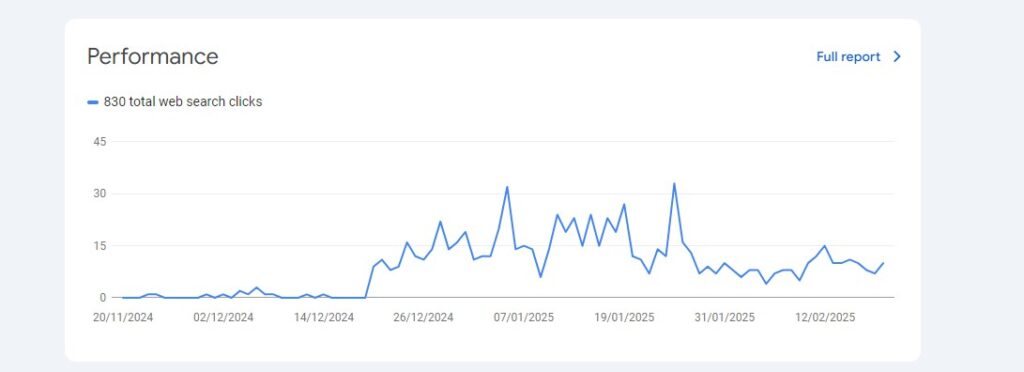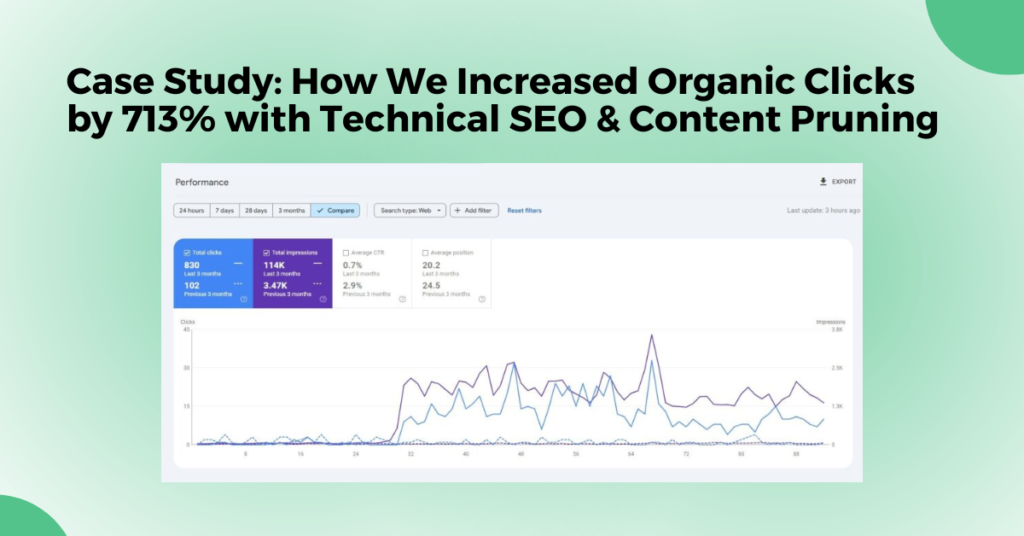Most businesses assume that publishing more content will automatically improve their SEO performance. However, in many cases, the real issue is not a lack of content, but how the existing content is structured, optimized, and interlinked.
In this case study, we will break down how we improved our website’s performance by focusing on technical SEO fixes, content pruning, and internal linking.
The results?
- 713% increase in organic clicks (from 102 to 830) in 3 months
- 3,200% increase in impressions (from 3,470 to 114,000)
- Improved average ranking position from 24.5 to 20.2
- More calls and inquiries from organic traffic
The most interesting part? We achieved this without publishing new content. Instead, we focused on fixing what was already there.
The Challenge
Despite having hundreds of pages and steady website activity, the organic traffic was not converting as expected. There were some calls coming in, but considering the number of clicks, the conversion rate was lower than it should have been.
Previous 3 Months Performance:
- Total Clicks: 102
- Total Impressions: 3,470
- Average Click-Through Rate (CTR): 2.9%
- Average Position: 24.5
Even though the site was getting indexed, it was not gaining enough visibility for competitive local searches. We needed to identify what was holding back performance and make strategic improvements.
Step 1: Technical SEO Audit
We started with a detailed technical SEO audit to pinpoint the key issues affecting search visibility. The audit revealed several problems:
- Outdated and low-value pages were reducing the site’s authority.
- Keyword cannibalization—multiple pages were competing for the same keywords.
- Weak internal linking—important pages were isolated and difficult to discover.
- Slow site speed was affecting both user experience and rankings.
- Unoptimized metadata—title tags and descriptions were not compelling enough to improve CTR.
These factors combined were preventing the website from achieving its full potential.
Step 2: Content Pruning & Cleanup
Instead of adding new content, we focused on removing unnecessary pages that were no longer contributing to traffic growth.
We analyzed the existing content and identified nearly 40% of the pages that were:
- Too thin to provide value
- Duplicates of other pages
- Competing for the same keywords
Actions Taken:
- Merged duplicate or similar content into more comprehensive pages.
- Redirected outdated pages to relevant, high-value content.
- Retained only the strongest pages with ranking potential.
By removing low-quality pages, we allowed Google to prioritize the remaining content, leading to an increase in search visibility.
Step 3: Optimizing Internal Linking
A well-structured internal linking strategy helps search engines understand the website hierarchy and improves user navigation.
Before optimization:
- Important pages were isolated, making them difficult to find.
- There was no clear linking structure, reducing topical relevance.
Actions Taken:
- Ensured that every key page had at least three to five relevant internal links.
- Strengthened connections between service pages and blog content to improve relevance.
- Used keyword-rich anchor texts to reinforce topic relationships.
These changes helped search engines crawl the site more effectively and distribute authority across important pages.
Step 4: Technical SEO Enhancements
Beyond content and internal linking, we implemented several technical improvements to enhance site performance:
- Improved page speed by optimizing images and enabling caching.
- Refined metadata with engaging, keyword-rich title tags and descriptions.
- Implemented structured data markup to improve search visibility.
- Enhanced mobile usability to ensure a seamless user experience across all devices.
These improvements contributed to better rankings, higher CTR, and increased user engagement.
Results After 3 Months
Following these strategic changes, the website’s organic performance improved significantly.

Updated 3-Month Performance:
- Total Clicks: 830 (713% increase)
- Total Impressions: 114,000 (3,200% increase)
- Average CTR: 0.7% (CTR declined due to content pruning but is expected to improve)
- Average Position: 20.2 (improved from 24.5)
More importantly, the website saw a noticeable increase in calls and inquiries, demonstrating that traffic was now converting into actual leads.
Key Takeaways
SEO is not always about creating more content. In many cases, optimizing existing content and fixing technical issues can yield better results.
Key lessons from this case study:
- Technical SEO matters—fixing speed, metadata, and structured data can improve visibility.
- Content pruning is essential—removing unnecessary pages helps Google focus on the most valuable content.
- Internal linking is a powerful ranking factor—a well-structured website improves both rankings and user experience.
- A strategic approach to SEO delivers better results than just publishing more content.
If your website is not delivering the expected results, it may not be due to a lack of content but rather how it is structured and optimized. Fixing technical issues, improving site speed, and strategically managing content can significantly boost performance.
SEO requires a strategic approach, and one-size-fits-all solutions rarely work. Every website is unique, and understanding what to fix and what to remove is key to long-term success.
To achieve the best results, it is recommended to seek professional help from an SEO expert. An experienced specialist can conduct a detailed audit, identify bottlenecks, and implement effective strategies to maximize your website’s potential.
If you need assistance with technical SEO, content optimization, or a comprehensive strategy, working with an expert can save time and ensure sustainable growth in search rankings and conversions.

My name is Suraj Rana, and I am a seasoned Dental SEO Specialist with extensive experience in the Dental SEO industry. Leveraging my deep knowledge and expertise, I help dental practices enhance their online visibility and attract more patients.


